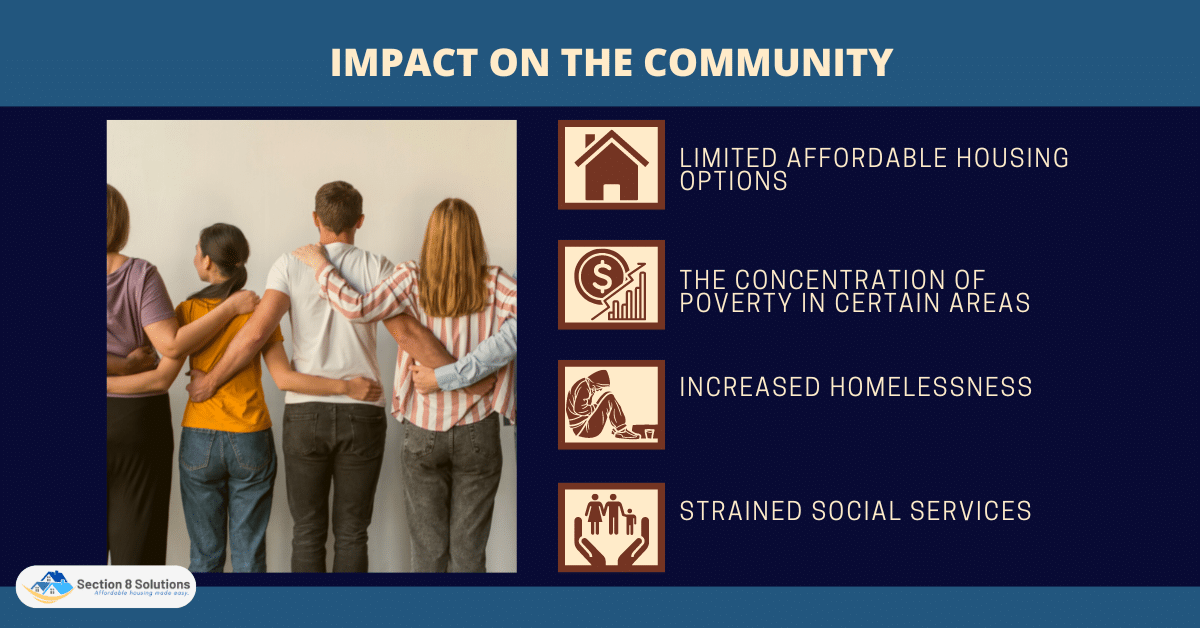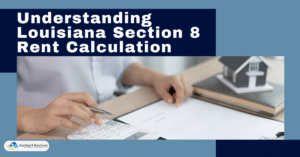Landlords ending their participation in the Section 8 program limits affordable housing options for vulnerable populations. Reasons include delayed rent payments, regulations, and tenant behavior. This impacts tenants and the community with limited housing options and increased homelessness.
This blog post aims to explore why landlords end their participation in the Section 8 program, the impact on tenants and the community, and potential solutions to encourage landlord participation in the program. It is important to address this issue to ensure that vulnerable populations have access to safe and affordable housing options and to prevent the concentration of poverty in certain areas.

Reasons Why Landlords End Their Participation in the Section 8 Program
Landlords ending their participation in the Section 8 program is a growing concern, leaving vulnerable populations struggling to find safe and affordable housing. There are several reasons why landlords choose to opt out of the program.
Reasons:
- Delayed rent payments: Landlords may experience delays in receiving rental payments from the government, which can cause financial strain.
- Strict regulations and paperwork: The program requires landlords to comply with strict regulations and paperwork, which can be time-consuming and burdensome.
- Fear of damage to their property: Landlords may worry about damage to their property by tenants who may not have the financial means to cover repairs.
- Tenant behavior concerns: Some landlords may have concerns about tenant behavior, such as illegal activities or disruptive behavior, that may put their property at risk.
- Low rental rates: The government sets rental rates for Section 8 properties, which may not be as profitable for landlords as market rates.
Landlords have various reasons for ending their participation in the Section 8 program, including delayed rent payments, strict regulations and paperwork, fear of damage to their property, tenant behavior concerns, and low rental rates. These reasons significantly impact vulnerable populations’ access to safe and affordable housing options.

Legal Requirements for Ending Participation in the Section 8 Program
When a landlord decides to end their participation in the Section 8 program, there are legal requirements that they must follow. These requirements are in place to ensure that tenants are not unfairly displaced from their homes and that the housing authority is properly notified.
One of the key legal requirements for ending participation in the Section 8 program is providing proper notice to tenants. Landlords must provide written notice to their tenants that they will no longer be participating in the program. The notice should include the effective date of the termination of the Section 8 agreement and the reason for the termination.
The notice must also inform tenants of their rights to continue receiving rental assistance from the housing authority and to find a new housing unit if they choose to do so.
In addition to providing notice to tenants, landlords must also provide proper notice to the housing authority. This notice must be provided at least 90 days before the Section 8 agreement is terminated. The notice should include the same information that was provided to tenants, including the effective date of termination and the reason for the termination.

Impact on Tenants
The decision of landlords to end their participation in the Section 8 program has a significant impact on tenants, particularly those who rely on the program to access affordable housing options.
When landlords opt out, tenants are left with limited housing options, which can have negative impacts on their mental health, force them to move, and disproportionately affect marginalized communities. In this section, we will explore the impact of landlords ending their participation in the Section 8 program on tenants.

Difficulty Finding Housing
The Section 8 program, also known as the Housing Choice Voucher program, is an essential lifeline for low-income families in need of affordable housing. This program provides eligible households with rental assistance vouchers that they can use to pay for a portion of their monthly rent. The program is designed to help low-income families, seniors, and people with disabilities live in safe, decent, and affordable housing. Without this program, many families would be forced to live in overcrowded or unsafe housing or become homeless.
However, the Section 8 program can only be effective if landlords are willing to participate in it. Unfortunately, many landlords opt out of the program, citing various reasons such as administrative burdens, low reimbursement rates, and negative perceptions of Section 8 tenants. This refusal to participate severely limits the housing options for tenants, especially in urban areas where affordable housing is scarce.
When landlords refuse to participate in the program, low-income families and individuals are left to compete for a limited pool of available rental units, leading to long waitlists and prolonged housing insecurity. This situation exacerbates the housing crisis in urban areas, making it even more difficult for low-income households to secure safe and affordable housing. It also reinforces patterns of residential segregation, where low-income families are concentrated in certain neighborhoods with limited opportunities for upward mobility.

Forced to Move
Forced moves can be a challenging and stressful experience for tenants, especially when they occur unexpectedly. One of the most common reasons for forced moves is property sales or landlord disputes, where landlords may decide to sell their property or have conflicts with their tenants that result in eviction. In such cases, tenants are forced to vacate their homes without much warning, leaving them with limited time to find alternative accommodation.
In other instances, tenants may face rent hikes or the end of a lease period, which can make it difficult for them to continue living in their current homes. Rent increases can lead to financial strain and make it difficult for tenants to afford their monthly payments, while the end of a lease period can leave tenants without a home if they are unable to secure a new lease or find a new place to live.
The sudden displacement can have significant implications for tenants, including emotional and financial stress, loss of social support, and disruptions to daily routines. Finding a new home can be a time-consuming and expensive process, with additional expenses such as moving costs, utility deposits, and rental application fees. Moreover, displaced tenants may have to relocate to areas with fewer resources or further away from their work or family, which can further exacerbate their challenges.

Negative Impact on Mental Health
Housing insecurity can have severe consequences for tenants’ mental and emotional health. The stress and anxiety associated with finding a new home or facing the prospect of becoming homeless can be overwhelming and have a significant impact on mental well-being. The constant uncertainty of housing insecurity can lead to depression, hopelessness, and a sense of powerlessness.
Moreover, the financial burden of having to move or pay higher rents can add to the mental strain. Many tenants may have to cut back on essential expenses, such as food or healthcare, to make ends meet, which can further exacerbate their mental and physical health.
The experience of homelessness can be especially traumatic, with many individuals experiencing trauma, violence, and abuse while living on the streets or in shelters. The lack of stability and security associated with housing insecurity can further undermine tenants’ mental and emotional health, leading to feelings of isolation and alienation.

Disproportionate Effect on Marginalized Communities
When landlords end participation in the Section 8 program, it disproportionately affects marginalized communities. These communities, especially low-income families, elderly, and disabled individuals, depend on the program for safe and affordable housing. The reluctance of landlords to accept Section 8 vouchers further limits the housing options for tenants in these communities, exacerbating rampant housing insecurity.
In summary, when landlords leave the Section 8 program, renters have trouble finding homes, must move, suffer mental health issues, and marginalized communities are disproportionately affected. These effects emphasize the need to address the issue and find solutions to guarantee everyone has safe and affordable housing.

Impact on the Community
The decision of landlords to end their participation in the Section 8 program affects tenants and has a broader impact on the community. When landlords opt-out, it limits affordable housing options, leading to concentrated poverty in certain areas, increased homelessness, and strained social services.
Here are some impacts on the community:

- Limited affordable housing options: When landlords end their participation in the Section 8 program, it limits the availability of affordable housing options for vulnerable populations, leading to a shortage of housing in certain areas.
- The concentration of poverty in certain areas: The limited availability of affordable housing options can lead to the concentration of poverty in certain areas, affecting the community’s overall economic and social well-being.
- Increased homelessness: The lack of affordable housing options can also lead to increased homelessness, which impacts individuals and strains community resources.
- Strained social services: The strain on community resources can make it difficult for social services to provide assistance to those in need, negatively impacting the community’s overall health and well-being.
Landlords leaving the Section 8 program reduces affordable housing, concentrates poverty, increases homelessness, and strain social services. This issue must be addressed to guarantee everyone has secure and affordable housing to improve the community’s health and well-being.
Solutions to Encourage Landlord Participation in the Section 8 Program
Encouraging landlord participation in the Section 8 program is crucial to ensure that everyone has access to safe and affordable housing options. Landlords ending their participation can limit these options, negatively impacting tenants and communities.
There are several potential solutions to encourage landlord participation in the program. Firstly, addressing concerns about delayed rent payments can help. Assuring landlords that they will receive timely rental payments from the government can help address concerns about the financial strain and encourage their participation in the program.
Secondly, simplifying regulations and paperwork can make it easier for landlords to comply with the program and reduce the burden of participation. Additionally, offering financial or other incentives for landlords who participate in the program can encourage their involvement and help offset potential financial risks. Finally, providing resources for tenant behavior management, such as training or support services, can reduce potential property damage, ultimately encouraging landlord participation.
Promoting landlord participation in Section 8 helps disadvantaged people find safe and affordable homes. To increase landlord engagement, address concerns about late rent payments, simplify rules and paperwork, offer incentives, and provide tenant behavior management resources. We can improve housing for the most vulnerable by applying these measures.

Conclusion
Addressing concerns about delayed rent payments, simplifying regulations and paperwork, offering incentives for participating landlords, and providing tenant behavior management services can encourage more owners to engage in the program. Doing so can reduce homelessness, offer more equitable and accessible housing options for vulnerable people, and improve our community’s social and economic well-being.
We can increase landlord participation by addressing concerns about late rent payments, simplifying rules and paperwork, creating incentives for participating landlords, and providing tenant behavior management options. Doing so can improve vulnerable populations’ housing alternatives, reduce homelessness, and boost our communities’ social and economic well-being.












